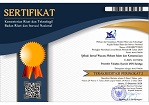Telaah kritis model screening saham syariah menuju pasar tunggal ASEAN
Abstract
years. the most important issue in Shariah stock is Stock screening mechanism. The aim of this study is
to examine the screening models of Shariah stocks in ASEAN countries. This study is very crucial
especially in the era of ASEAN economic community (AEC). In addition, this study aims to examine
some of the factors that contribute to the differences in screening models applied in five ASEAN
countries. By using descriptive method and literature studies approach, this study found a few things.
Firstly, there are various models of Shariah stock screening in Indonesia, Malaysia, Singapore, Thailand
and Philippines. In this context, the model screening in ASEAN countries have two tendencies, namely;
for the country in the majority of the population is Muslim whereby there are many Sharia expert, then
they will use the specific screening model and applied only in the country, while for the country that the
majority is not Muslim, then they will tend to use models of screening that has been used globally for
example DJIM, FTSE, etc. This second pattern has been applied by Singapore, Thailand and Philippines.
Secondly, differences in shariah screening models influenced by several factors, namely; differences
in social structure of a country where the Islamic stock market is located; the difference in the financial
industry that exist in the country will affect on the difference of screening models; and differences sect
embraced by most scholars in a country is one of the fundamental factors in determining stock screening
model of sharia in 5 ASEAN Countries.
Keywords
Full Text:
PDFReferences
Abdul Rahman, A., Yahya, M. A., and Mohd Nasir, M. H. “Islamic Norms for
StockScreening a Comparison Between the Kuala Lumpur Stock Exchange Islamic
Indexand the Dow Jones Islamic Market Index” dalam International Journal of Islamic
and MiddleEastern Finance and Management, Vol. 3 No. 3, (2010): 228-240.
Al-Ghazali. Al-Mustashfa. Beirut: Da>r al-Fikr, 1997.
Ardiansyah, Misnen and Abdul Qoyum, “Testing the Semi-strong Form Efficiency of Islamic
Capital Market With Response to Information Content of
DividendAnnouncement: A Study in Jakarta Islamic Index”, dalam Journal of Modern
Accounting and Auditing Vol. 8, No. 7,(2012): 1025-1041.
Derbel, Hatem, Bouraoui, Taoufik, &Dammak, Neila. “Can IslamicFinanceConstitute a
Solution to Crisis,”dalam International Journal of Economics and Finance Vol. 3 No.3, (2011).
Derigs, Ulrich, andMarzban, Shehab. “Review and analysis of currentShariah-compliant
equityscreening practices,” dalam International Journal of Islamic and Middle Eastern Finance
and Management, Vol. 1 No. 4, (2008): 285-303
Derigs, Ulrich, & Marzban, Shehab. New strategies and a new paradigm for syariah-compliant
portfolio optimization dalam Journal of Banking & Finance, Vol. 33, (2009), pp.
Dusuki, Asyraf Wajdi (ed.).Islamic Financial System; Principle and its Operation, Kuala Lumpur:
ISRA Publication, 2012.
Dusuki, A. “Practice and Prospect of Islamic Real Estate Investment Trusts (IREITs) in
Malaysian Islamic Capital Market”, dalam Journal of Islamic Economics, Banking and Finance,
Vol. 6, No. 2, (2011), 25-40
El-Ashkar, Ahmad Abdel Fattah. “Towards an Islamic Stock Exchange in aTransitional
Stage.” Dalam Islamic Economic Studies Vol. 3 No.1 (1995): 79–112.1995
Fama, Eugene F., & French, Kenneth R.”Multifactor Explanations of Asset Pricing
Anomalies,”dalam The Journal of Finance Vol. 51 (1), (1996).
Fatwa Dewan Syari’ah Nasional No: 40/DSN-MUI/X/2003 Tentang Pasar Modal dan
Pedoman Umum Penerapan Prinsip Syariah di Bidang Pasar Modal
Febrian, Erie, &Herwany, Aldrin. “Volatility ForecastingModels and MarketCo-integration:
A study on South-east Asian Markets,”dalam The Indonesia Capital Market Review Vol. 1
No. 1 (2009).
Febrian, Erie, &Herwany, Aldrin. “The Performance of Asset Pricing Models Before, during,
andafter Financial Crisis In Emerging Market: Evidence from Indonesia,”dalam
The International Journal of Business and Finance Research Vol. 4 No. 1 ( 2010).
Guyot, Alexis.”Efficiency and Dynamics of Islamic Investment: Evidence of Geopolitical
Effects on Dow Jones Islamic Market Indexes,”dalam Emerging Market Finance &
Trade Vol. 47 No. 6 ( 2012).
Herwany, Aldrin, &Febrian, Erie. “Co-integration and Causality Analysis on
DevelopedAsianMarket for Risk Management&PortfolioSelection,” dalam Gadjah Mada
International Journal of Business Vol. 10 No.3 (2008).
Kamali, M.H., 1996. “ Islamic Commercial Law: An Analysis of Futures” dalam The
American Journal of Islamic Social Sciences, Vol. 13 No. 2 (1996): 197-224
Kassim, Salina H.”Global Financial Crisis of Islamic Stock Markets in Developed and
Developing Countries,” VRF Series, 2010.
Kassim, Salina H., “The Global Financial Crisis And The Integration Of Islamic Stock
Markets In Developed And Developing Countries” dalam Asian Academy Of Management
Journal Of Accounting And Finance, Vol. 9, No. 2 (2013): 75–94.
Majid, M.Shabri Abd. and Salina H.Kassim,”Potential Diversification Benefit Accross Global
Islamic Equity Market” dalam Journal of Economics Cooperation and Development Vol.31
No. 4 ( 2010): 103-126.
Marzban, Shehab and Mohamed Donia, “ Shariah-compliant
Equity Investments
Frameworks,Trends andCrisis” dalam Harvar dIslamic Finance Forum Paper, (2010).
Mian, K. M., ‘Shariah screening and islamic equity indexes’, Islamic Finance: A PracticalGuide
(2008): 25–39.
Omar, Moh. Azmi et.al.. Fundamental of Islamic Money Market and Islamic Capital Market,
Wiley, Singapore; 2013.
Sani, N.A. and Othman, R. “ Revision of Shariah Screening Methodology: The Status of
Shariah-Compliant Companies in Malaysia” dalam Proceedings of the 3 rd International
Conferenceon Management (3rd ICM 2013), Malaysia, (2013): 51-63.
DOI: https://doi.org/10.18326/ijtihad.v16i2.197-216
Refbacks
- There are currently no refbacks.

This work is licensed under a Creative Commons Attribution-ShareAlike 4.0 International License.
Ijtihad: Jurnal Wacana Hukum Islam dan Kemanusiaan by http://ijtihad.iainsalatiga.ac.id/ is licensed under a Creative Commons Attribution-ShareAlike 4.0 International License







